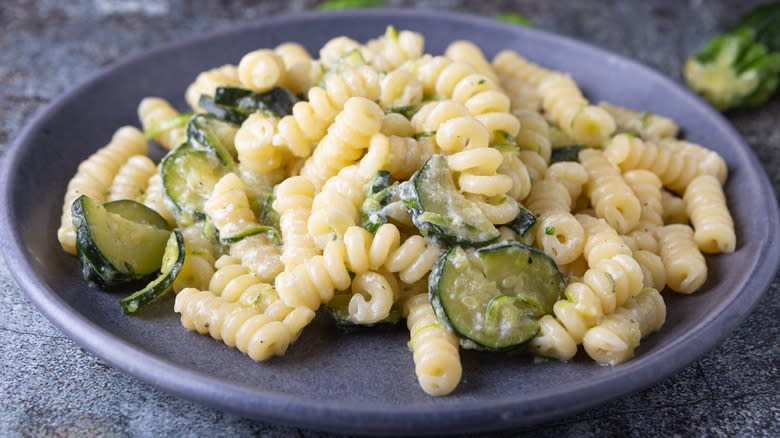Goat Cheese Makes For A Tangy Pasta Dish, No Sauce Needed

Instead of mulling over another mundane array of jarred marinara or alfredo sauces, goat cheese is the only ingredient you need for a zesty, creamy pasta sauce. Known for its distinctly tangy and pungent gaminess, goat cheese encompasses numerous varieties, textures, and flavor profiles, from cheddar to brie to blue cheese. While any type of goat cheese will make for a savory and rich addition to pasta, the way you incorporate it into a pasta dish depends on its firmness or creaminess.
The most common goat cheese varieties are the soft, spreadable chèvre cheeses shaped into packaged logs. This variety is also the easiest to break down and melt into a sauce. The residual heat of the pasta as well as a dash of hot pasta water are all you need to turn a log of goat cheese into a sumptuous, velvety sauce that will coat the pasta and any add-ins. Furthermore, chèvre logs come in a variety of flavors and are often marinated in herb or tomato-infused oils, adding even more complexity to a pasta dish.
Soft goat cheese is either fresh or aged for up to two weeks, and has a pronounced gaminess and tangy finish. A harder goat cheese, meanwhile, will provide more complex flavor notes, from nutty to smoky. You can also shred these firmer cheeses over fresh, hot pasta with a bit of melted butter for a gooey consistency that'll stick to the noodles and create a decadent, pullable dish. Consequently, shorter, fatter pasta shapes like conchiglie, macaroni, rigatoni, and farfalle are ideal.
Read more: 26 Types Of Pasta Sauce Explained
Try These Great Pasta, Goat Cheese, And Add-In Combos

While goat cheese is a simple, one-ingredient substitute for pasta sauce, you can still spruce it up with staples like herbs, spices, citrus, oil, and butter. Furthermore, garnishes and heftier add-ins like meat and veggies will make your pasta into a more well-rounded meal. A bit of pasta water will melt and thicken goat cheese sauce into a cohesive coating. The salted, starchy water will also mellow and season the tart cheese. However, a sprinkle of fresh cracked pepper or red pepper flakes would provide the perfect spicy complement.
You could also grate lemon zest and fresh garlic to stir into the creamy goat cheese for a burst of aromatic and citrus flavors. Onion powder, garlic powder, and lemon pepper would be a great seasoning trifecta. Fresh rosemary, thyme, tarragon, and parsley as well as dried oregano and sage are also welcome savory, herbal complements to tangy, gamey goat cheese. As for add-ins, goat cheese pairs well with sweet ingredients like candied butternut squash, sweet potatoes, beets, and dried fruit.
Use a log of goat cheese instead of butter along with sage for a delectable sauce for sweet potato gnocchi. Robust umami and bitter flavors also work well with goat cheese; strips of steak, Brussels sprouts, sun-dried tomatoes, olives, and mushrooms would all taste delicious as goat cheese pasta inclusions. And a dusting of Parmesan cheese and a sprinkle of toasted pine nuts, pistachios, or walnuts would provide an enyoyable crunchy contrast and savory complement to your goat cheese sauce.
Read the original article on Tasting Table.


